TR: Mt. St. Helens (21 June 2012)
(Last Updated On: )
Mount Saint Helens is certainly not the tallest volcano in the US. But, it is probably the most famous volcano due to it’s explosive eruption in May, 1980. St. Helen’s got ticked off with the world and blew her own head off, killing acres and acres of trees, and leaving piles of ash and dust everywhere.
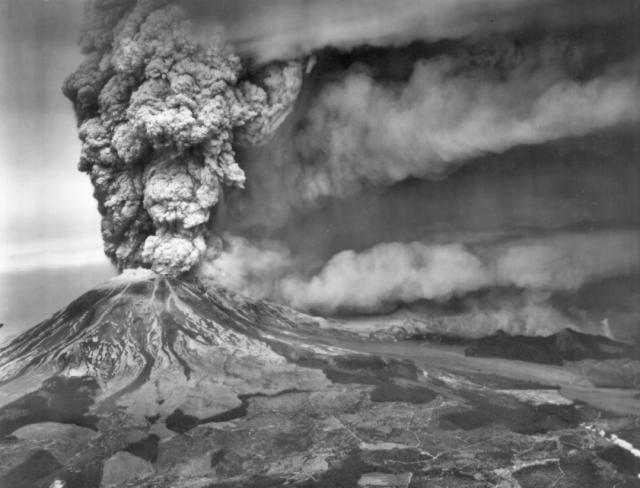
But that was not the end. Though St. Helens now stands about 1300 feet shorter, it’s explosion has created a new landscape that is springing into life. One of the best examples of this is Spirit Lake, which lies on the northern slopes of St. Helens. During the eruption, the lake was filled with so much lava and ash that the lake rose 200 feet. These deposits and other volcanic gases made the lake so toxic, scientists thought it would take hundreds of years for the lake to recover. But recovery is happening much faster than expected.
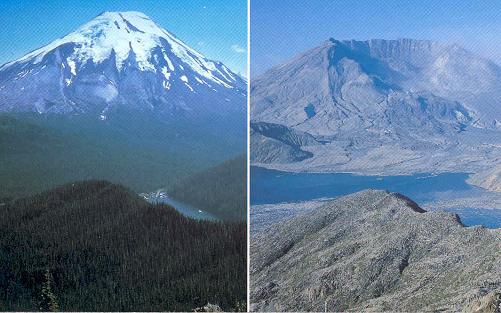
Due to it’s infamy, St. Helens has become one of the most climbed volcanoes in the States. And believe me, it has the crowds to show it too. Though we knew the skiing might yield steep and exciting turns, we still felt the yurning of this historic natural landmark.
Post-eruption access to the summit is currently all done from the south side, though there is talk of the Forest Service building a trail from the north soon. We first tried to reach the Climber’s Bivouac trailhead at 3800′, but the road was closed due to snow. Should we expect anything less. So, just like snow added 1000′ to our climb on Adams, snow added 1200′ to our climb on St. Helens. Just another hour, I thought to myself.
We parked at the Sno-Park at 2640′ and found very dry conditions. We knew we’d be walking some miles on trail instead of snow. So we started out in hiking boots right away.

Even when we first spotted the snow we longed to be climbing on, it was still an hour away. Perspective is misleading here in the Pacific Northwest. It’s hard to believe that this peak is capped with well over 3000′ of snow here…. Everything is bigger than it seems.

We walked for two hours on dirt before finally reaching the snow. Instead of following the main ridge route, we opted to escape the line of ants and climb up a gully just to the right of the ridge. We were happy to be away from the masses for a bit.

Me climbing up the gully with Mt. Hood in the distance.

But, the gully was hot. Protected from the breeze and with sun reflecting all around us like we were the focus in a parabolic solar dish, I was really hot. My pace slowed. I couldn’t deal with it anymore. I puked on the snow.
I don’t handle heat very well – ever since I hiked the Grand Canyon rim to rim in a day in 115-degree temperatures. I was 19 and didn’t know about electrolytes and that I needed to not only be drinking water, but to be eating food so that my body could actually absorb the water. Instead, it sloshed around in my belly for hours, and I eventually puked up some sort of green slurry. I suffered heat exhaustion that day. But, I made it out eventually.
I took a few steps away from the green-colored snow and sat down. Remembering the electrolyte lesson from my Grand Canyon experience, I took a sip of water and grabbed a gel, gulping it down as fast as I could because the taste of anything and everything in my mouth made my stomach churn. I’ll admit, I wanted to quit. But I don’t want to have to hike all those miles of dirt just to come back again, I thought to myself. So, I pushed up my sleeves, shoved some snow in my sunhat and put it on my head, and continued on climbing toward Matt whom I’m sure was wondering what the heck was taking me so long.
Matt and I were on the same page. We both agreed it was hot, and that we had to get out of the gully as soon as we could. So, we climbed out of the solar dish and onto the ridge. We were rewarded with a breeze, but we also found ourselves surrounded by the masses.
We generally stayed climber’s left of the main route to avoid feeling like we were miner’s on the Chilkoot Trail. Note the bergschrund in the snow between us and the other climbers. Yale Lake is in the distance.

We finally reached the top of the ridge and the volcano crater. Adams coming out to greet us.

But, due to a very dangerous cornice on the crater, we could not peer over into the crater itself until we downclimbed a little to the east. The views were worth it.

The crater, Spirit Lake, and Rainier obscured by clouds.

Though I could have lingered there for awhile, with the unexpected extra vert and the bad heat, our climb had taken longer than we expected. It was time to ski. Matt.

I put together a video from the helmet cam footage we captured. The video really captures the perspective of how big everything is, even if it doesn’t look like it. We skied over 3000′ back to the trail, about half of which is actually covered in the video.
Mount St Helens Ski (21 June 2012) from 14erskiers on Vimeo.
Upon reaching the dirt trail, the ski boots came off and the hiking shoes came back on.

I wished I’d been smart enough to bring shorts.
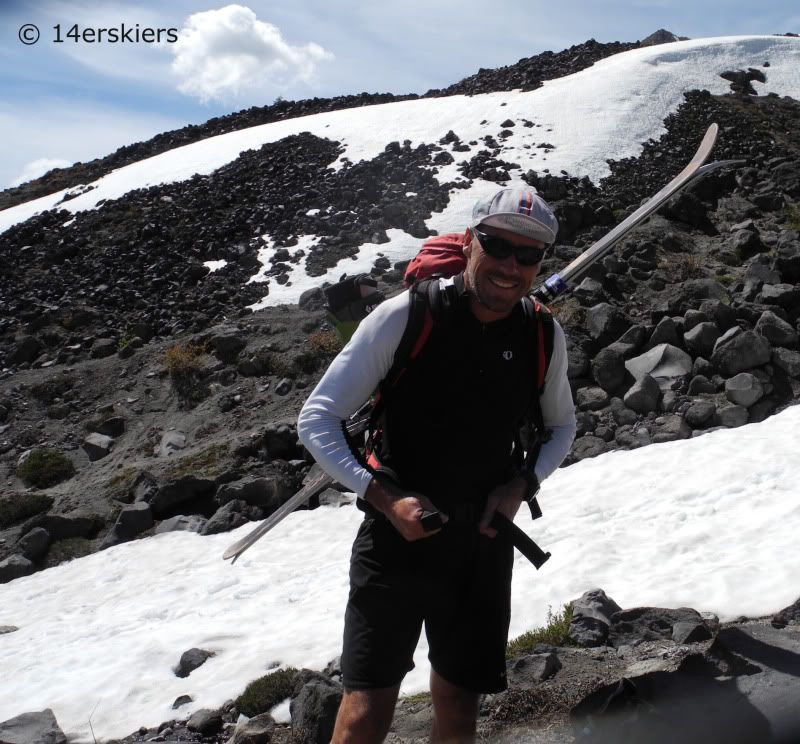
And then we continued down, walking two more hours to the car.

Matt and I were tired after three days of skiing the three volcanoes in the area – Mt. Hood, Mt. Adams, and Mt. St. Helens. But, we felt completely satisfied. With inclement weather moving into the Pacific Northwest for the next few days, we knew our ski trip was done. Thanks to Matt for agreeing to join me on another crazy adventure!
We stopped to snap one last shot of our third objective, St. Helens.

Though we’d skied our three primary objectives, a trip like this always creates a desire. I think I’ll be coming back for more 🙂
Links to Other Reports from this Trip:
Volcano-Bound!
From SLC to Shasta
Shasta Ski (14 June 2012)
Shastarama Ski (16 June 2012)
Lassen Peak – Closing a Volcano
Oregon Days Off
Mount Hood (19 June 2012)
Mount Adams (20 June 2012)
Mt. St. Helens (21 June 2012)
From the Gorge to Craters
- Mount Buckskin (17 May 2020) - May 28, 2020
- Horseshoe Ski (14 May 2020) – The mountain whose journey nearly killed me - May 27, 2020
- Sayres X-Rated Ski (10 May 2020) - May 19, 2020

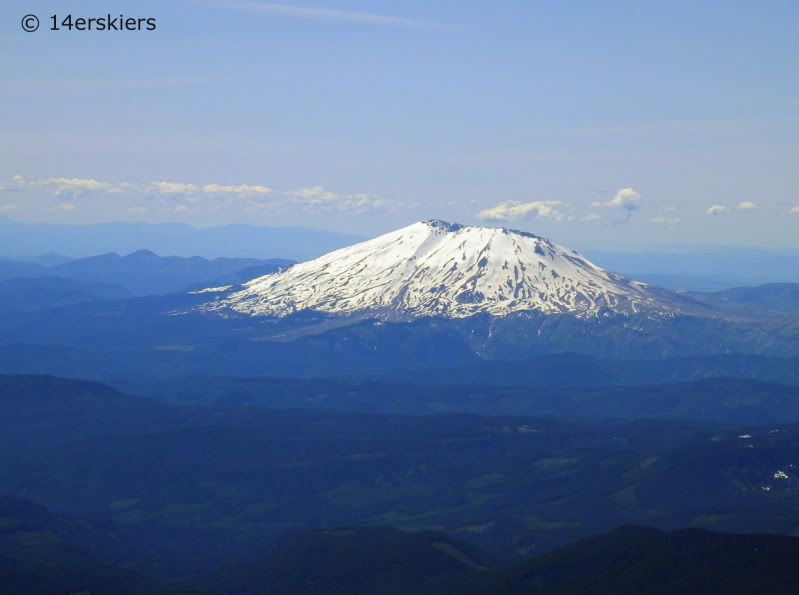


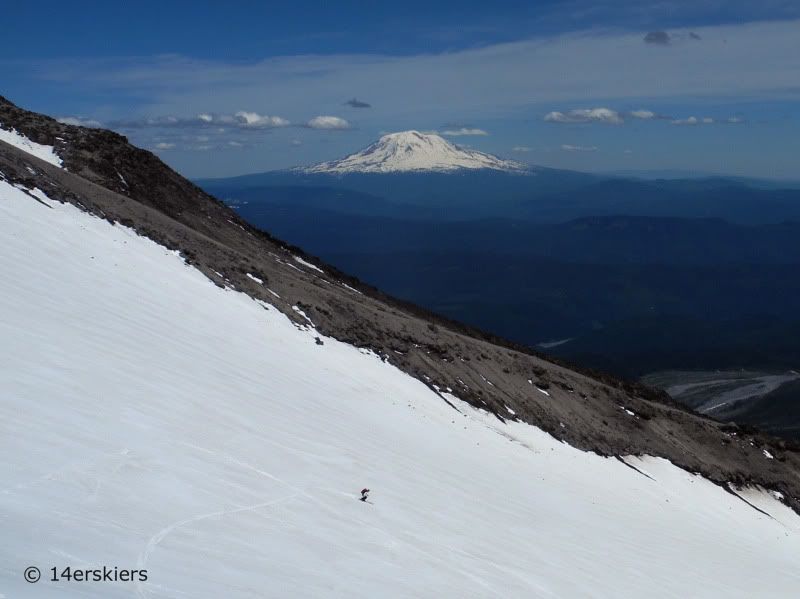


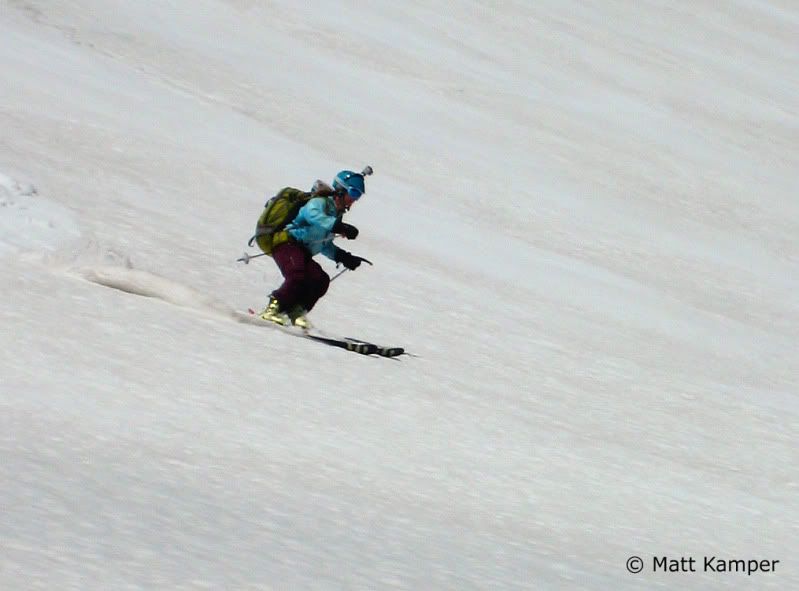



These volcano trip reports have been great! Thanks for sharing.